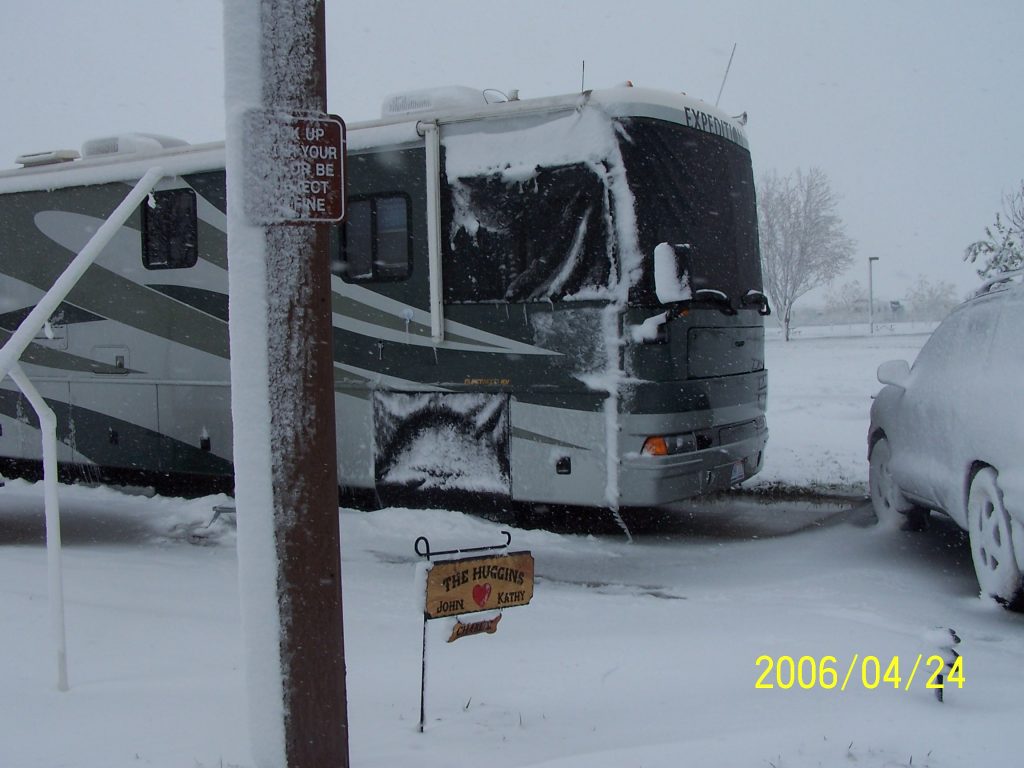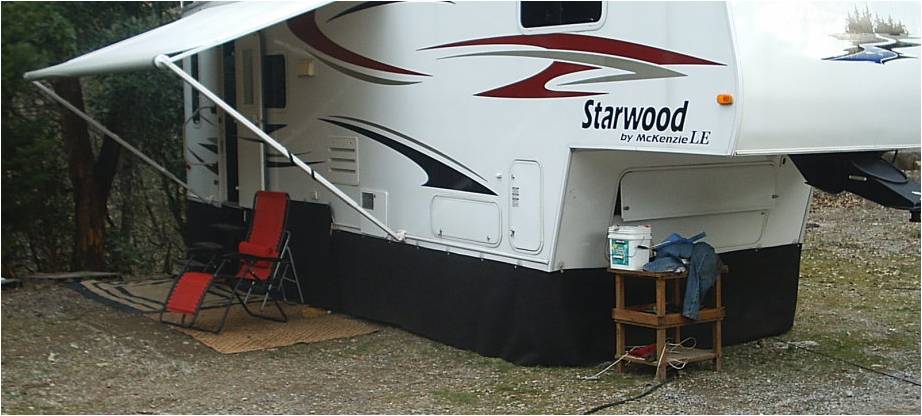Winter RVing can be a lot of fun. Although most folks prefer to use their RV’s during the warmer times of the year, there are circumstances when you might want or need to do some winter RVing. There are less people at campgrounds(if they are open at all), you may enjoy winter sports like cross country skiing, ice fishing or snowmobiling. Perhaps a family member is sick and you need to be near them. No matter the reason, there are a number of things you must know in order to have a safe and comfortable winter RV experience.

You must concern yourself with keeping your fresh water line from freezing. The same goes for sewer lines. You must concern yourself with how to keep your holding tanks from freezing. You must learn how to conserve propane and the best way of connecting it to your rig. Winter camping will require you to figure out the best way to add insulation and wind protection to keep comfortable. How will you handle snow and ice accumulation on your RV? You will also need to control condensation that forms inside your RV.
Driving an RV in Winter Weather
There are also considerations for driving or towing an RV during winter weather conditions. Some folks use chains for the RV. That isn’t a choice I would make as they are heavy, need to be stored, and sometimes difficult to put on. Stay in Camp until the weather clears sufficiently so chains are not needed.
If you must drive your RV in winter weather, stay on the main, well traveled roads, especially during bad weather. Use winter tires if applicable. Carry all the emergency materials you would use for any type of extreme weather, including a weather radio, blankets, water, flashlights, extra batteries, a GPS unit and food in case you do get stuck. Stay with your rig as hypothermia can be a in cold, wet conditions. Notify someone of your in case you get in trouble. Carry your cell phone. This might be a use for a CB radio.
Preparing the Fresh Water System for Winter RVing
You must prepare your RV for winter RVing. If you will be in a campground with a working(and hopefully heated) shower house, you might winterize the water system and not use it at all. I’m not sure I would like to get up and go to the shower house in the middle of the night to use the bathroom. Assuming you will use all the facilities of your rig, we will start with the fresh water system.
You will want a heated water hose to connect to the park water system. Year round parks often have heated pipes from deeply buried water lines so they won’t freeze. You will plug in your heated hose to the regular hose bib. You can insulate the exposed part of the hose bib with bubble wrap wrapped over with duct tape. If you can’t afford a heated hose, you can purchase a length of electric heat tape. Lay the heat tape out along the length of the hose. Secure it at 1 foot intervals with electrical tape. Then cover the hose and heat tape with foam pipe insulation. Secure it with duct tape. Plug it in to a thermostatically controlled outlet and then into the 20 Amp connection at the park electrical pedestal. So far so good. It is a good practice to place a drop light with a 50 watt bulb in the wet bay where the water hose is connected. This will keep the bay with all its water plumbing warm and frost free.
If your rig has heating pads installed on the bottom of the fresh water tank and the gray and black water holding tanks, you are good to go! If not, you must run your propane furnace(s) occasionally to keep them from freezing. The other alternative is to buy after market heating pads made for RV holding tank use. They come in 120 volt AC and 13.5 volts DC. Check out the offerings from UltraHeat, Inc. at http://www.ultraheat.com/tank_heaters.html

I would suggest keeping the sewer hose stored until you need to use it. Heat tape will probably melt the plastic material and cause a leak in the sewer hose. Once used, drain the hose and store it away until you need it again. This means keeping the cap on the park sewer opening. You might want to mark its location with a wire coat hanger if snow is expected. I wouldn’t want to go searching for it after a new snowfall. Isn’t winter RVing fun?
Insulating your RV for Winter RVing
This is probably the best thing you can do to stay comfortable for winter RVing. Windows and doors are a constant source of air leakage. If your rig has dual pane windows, great! Just remember that the windshield on motorized units is not dual pane nor is the window in the entrance door on side door models. The windshield can be covered with pleated foil available under the Reflectix brand name and available in hardware stores and RV supply shops. Cut it to fit and tape it in place, then pull the curtain closed to add another barrier. An excellent way to insulate single pane windows is with plastic storm window kits also available at hardware stores. This lets you see out of the windows.
There are thick cut-to-fit foam insulation products available at RV supply shops to place inside the vents to prevent heat loss there. Home style insulating tape can be placed in loose fitting doors to keep them weather proof. You might consider insulated Styrofoam panels to go inside the cabinets on the outside wall. This is another place cold air enters. Many people leave cabinet doors open so the insides get heated. There are water lines inside many cabinets.
Wind is a big reason RV’s get cold in winter. They are up on wheels so the wind blows right under. This is the reason bridge roadways freeze up first. The cure for this is skirting for motorized and towable RV’s. Custom skirts can be purchased made of a vinyl material with snaps. They must be held to the ground with rocks or other weights. You can make your own skirting quite inexpensively with plywood held in place with stakes. Make sure to put skirting all the way around all four sides. Some folks will be tempted to use hay bales. This has several drawbacks. It is an extreme fire hazard around propane fired appliances. Secondly, it will attract mice and other rodents. There has been much material written on protection from mice and other critters. Some folks use moth balls, some essential oils, some commercial dryer sheets. Use whatever works for you, because mice want to be warm too.

Handling Condensation
Now that you have your rig well buttoned up and as air tight as you can, you need to consider condensation. It will form especially on windows, but also on ceilings as well. It’s part of the price you pay for being warmer than the outside air. A wonderful product called Damp-Rid can help quite a bit as well as providing some small amount of outside ventilation. A dehumidifier can be helpful as well, but must be emptied constantly.
Using Propane Appliances in Winter
Propane is the fuel of choice for most RV appliances. It powers refrigerators, stove tops and ovens, as well as RV furnaces. Unfortunately, the typical RV forced air furnace is very inefficient, and blows a lot of heat outside. Using just propane fired forced air furnaces can empty an RV propane tank within 2 days. We are forced to use them some of the time to keep basement compartments and holding tanks from freezing for winter RVing.
There are several solutions. One is to use electric space heaters to supplement the furnace. The ceramic Disk units are small and produce an amazing amount of heat. Another is to use a propane fired catalytic heater. Buy one now These are almost 90% efficient and warm gently. We use a 6000 Btu unit that keeps us warm inside with occasional use of the furnace.
Under no circumstances should you use your propane oven for heat. If propane is burned in this way for just a few hours, levels of carbon monoxide (CO) can become deadly. Use the furnace or a propane heater rated for RVs. Always clear away snow and other obstructions from water heaters, refrigerators or vents. Make sure your CO detector is less than 5 years old and is operating. Even with a catalytic heater, some ventilation is the smart way to go. Just a small opening in a vent and another window is enough.
The best thing we have done is install an “Extend-a-Stay” valve in the propane line just on the downstream side of the pressure regulator. This allows connection of another propane tank to supplement your RV’s on-board tank. There is a valve to isolate your tank while using the outboard tank. This way, you don’t need to move your rig, just go get the outboard tank filled again. This makes winter RVing almost easy.
Snow is not your friend
You have probably heard that snow is a good insulator, and it is, for igloos. For winter RVing, the snow will melt and refreeze as ice next to the roof or walls of your RV. Show on the roof will quickly exceed the rated roof weight load and should be brushed off after the storm stops. It is especially important to remove it from slide tops and slide top awnings. It’s OK to have it lap up against the skirting, as it will help to insulate that.
I hope you try winter RVing at least once. You will see a side of nature rarely seen. You can follow and identify animal tracks, enjoy the silence only a cold winter day brings, and return to your warm secure RV to warm up. You will also experience a season most RVers do not even try.
